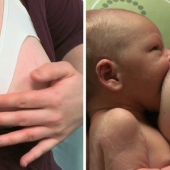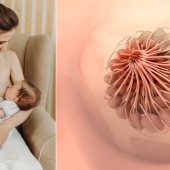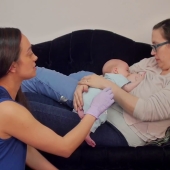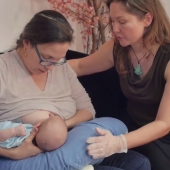Towards the end of pregnancy, women start making colostrum in the breasts. Colostrum is the very first milk that baby will receive. It's quite a thick, sticky substance. It's packed full of anti-bodies and we sometimes talk about it being baby's first immunisation.
Some mum's are really aware of that colostru towards the end of pregnancy and other's don't notice it at all. And that will be there for the first few days after your baby is born. After a few days, after baby is born, the milk changes. And women start producing milk as we understand it.
And women can feel quite uncomfortable at that stage. Sometime's we call it being engorged. So breasts can feel very hard and swollen and full. And it can be really difficult for mum's to feel comfortable and also for baby's to be able to latch on the breast.
If women are experiencing their breasts feeling very swollen and full of milk, and uncomfortable, there are a few things that they can do to help at home. So, having a warm bath or a shower, getting a warm flannel on their breasts or expressing a little bit of milk to help them feel a bit softer or even getting some help from the midwife who will still be supporting families at that point.
One of the main ways of helping breastfeeding go well is by helping babies be really well attached onto the breast. And the way you sit with your baby or lie with your baby can make a really big difference to how well that works.
We very much talk about baby's needing to breastfeed rather than nipple feed, they need to have a really big mouthful of breast tissue so they can effectively get as much milk as they can. To do that, mums can do a few things to really help their babies.
They can lean back, so that gravity helps to pull baby onto the breast and we also talk a little bit about nose to nipple. And tummy to mummy. Nose to nipple, so that baby's have to tilt their heads really far back, so that the nipple is aimed really far back to the roof of baby's mouth, to the soft palate. So that it's not hurting mum's nipple, and they need to be able to have their heads free to tilt back to be able to do that.
We also talk about tummy to mummy, so that babies are really comfortable so that their heads and their shoulders are in line with each other. So that they are really comfortable, to stay in that position and keep swallowing the milk.
We can see, watching mum's feed their babies, how well attached babies seem to be at the breast. And we look for really key things, so we look for baby's cheeks being full and rounded and look for baby's chin being indented into the breast.
We look for more of that dark skin of the areola, visible above baby's top lip rather than their bottom lip so we look for a moustache rather than a beard on baby's face. And we listen for rhythmical sucks, in the early days with a new baby and in fact, always, with a fairly new baby... lots of skin to skin is really beneficial for helping getting breastfeeding going.
It helps babies to get used to being on mum's chest and straight after birth it's fantastic for helping maintain baby's body temperature. So mum's temperature rises in order to protect her baby's body heat and it's also really good for helping babies feel mum's heartbeat and smell mum and feel really comfortable as well as encouraging that hormonal reaction - which encourages breastfeeding.
- 4622 views













